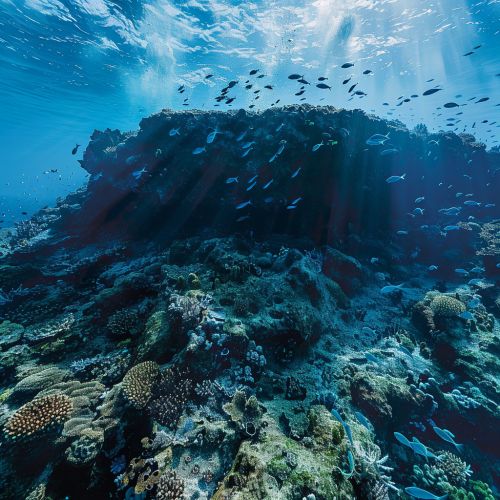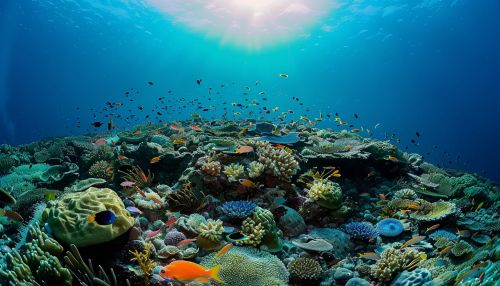Emperor Seamounts
Introduction
The Emperor Seamounts are a chain of underwater mountains in the Pacific Ocean, extending from the Aleutian Trench in the north to the Hawaiian Islands in the south. These seamounts are a significant geological feature, providing valuable insights into the processes of plate tectonics, volcanic activity, and the geological history of the Pacific Ocean basin. The Emperor Seamount chain is part of the larger Hawaiian-Emperor seamount chain, which is a classic example of a hotspot track.
Geological Formation
The formation of the Emperor Seamounts is attributed to the movement of the Pacific Plate over a stationary hotspot in the Earth's mantle. As the plate moved in a northwesterly direction, volcanic activity at the hotspot created a series of volcanoes. Over time, these volcanoes were carried away from the hotspot by the moving plate, eventually becoming extinct and eroding into seamounts. The age of the seamounts increases with distance from the current location of the hotspot, which is presently beneath the Hawaiian Islands.


Structure and Composition
The Emperor Seamounts are composed primarily of basalt, a type of volcanic rock that forms from the rapid cooling of lava. The seamounts exhibit a variety of shapes and sizes, ranging from flat-topped guyots to steep-sided volcanic cones. The flat tops of many of these seamounts suggest that they were once islands that have since subsided below sea level due to thermal contraction and erosion.
The seamounts are also characterized by their complex geological structures, including rift zones, calderas, and lava flows. These features provide evidence of the volcanic processes that formed the seamounts and offer clues about the dynamics of the hotspot and the movement of the Pacific Plate.
Biological Significance
The Emperor Seamounts are home to a diverse array of marine life, including deep-sea corals, sponges, and various species of fish. The unique habitats provided by the seamounts support a high level of biodiversity and are important for the study of deep-sea ecosystems. The seamounts also serve as stepping stones for the dispersal of marine species across the Pacific Ocean.
The complex topography of the seamounts creates a variety of ecological niches, which are exploited by different species. For example, the steep slopes and rocky outcrops provide ideal habitats for sessile organisms such as corals and sponges, while the flat tops and sediment-covered areas are inhabited by mobile species such as fish and crustaceans.
Tectonic Implications
The study of the Emperor Seamounts has provided valuable insights into the processes of plate tectonics and the dynamics of the Earth's mantle. The alignment of the seamounts along a linear trend is consistent with the theory of hotspot volcanism, which proposes that volcanic activity is driven by a stationary plume of hot mantle material rising to the surface. The change in direction of the seamount chain, known as the "Hawaiian-Emperor bend," is believed to reflect a shift in the direction of the Pacific Plate's movement around 47 million years ago.
The age progression of the seamounts, with the oldest seamounts located furthest from the hotspot, supports the idea that the Pacific Plate has been moving over a stationary hotspot for tens of millions of years. This age progression has been confirmed through radiometric dating of rock samples collected from the seamounts.
Research and Exploration
The Emperor Seamounts have been the focus of numerous scientific expeditions and research projects. These studies have utilized a variety of techniques, including bathymetric mapping, seismic surveys, and submersible dives, to investigate the geological and biological characteristics of the seamounts.
One notable expedition was the Ocean Drilling Program (ODP), which conducted drilling operations on several of the seamounts to obtain core samples for analysis. These samples have provided valuable information about the age, composition, and volcanic history of the seamounts, as well as insights into the processes of seafloor spreading and plate tectonics.
Conservation and Management
The unique ecosystems of the Emperor Seamounts are vulnerable to human activities such as deep-sea fishing and mineral extraction. These activities can have significant impacts on the fragile habitats and biodiversity of the seamounts. As a result, there is growing interest in the conservation and management of these important marine environments.
Efforts to protect the Emperor Seamounts include the establishment of marine protected areas (MPAs) and the implementation of sustainable fishing practices. International cooperation and collaboration are essential for the effective management of these transboundary ecosystems.
